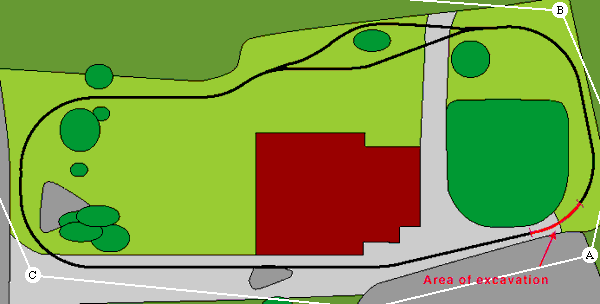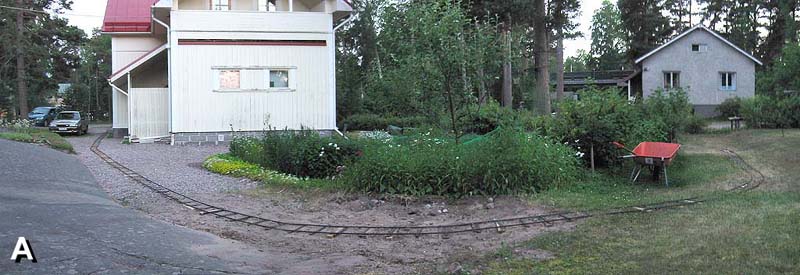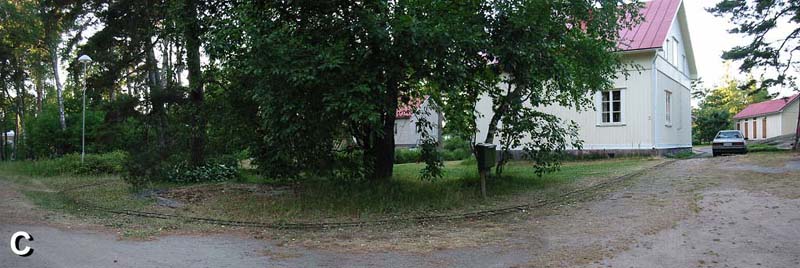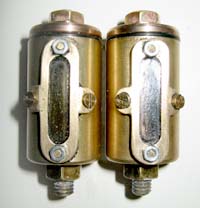Having done some more digging myself, going down about one foot below the original surface, I was finally able to lay the track around the garden, as I had originally planned:

Three 120-degree panoramics, shot from the points marked on the sketch above:



The total length of this track is now 130 meters, 400 ft. Fortunately, as can be seen on the drawing above, there was relatively little earth to remove to get the grade of the hump down to manageable proportions. Both locos can now run past the corner of the garden - albeit only counter-clockwise. The downward grade, after rounding the corner of the garden, is still about 7 %, and also sharply curved, so it is totally impossible to negotiate in the other direction.
The 3003 manages the current layout with a full load of 4 cars with passengers (max 2 adults, 2 kids), provided you get up the speed on the straight before any of the upward grades. Without some reserve speed, the 3003's drivers just slip on the grade! The "Quickie" has stamina enough to run the grade at its own, slow pace, thanks to its lesser tendency to slip.
Incidentally, I clocked both engines on the "long" (70 ft), level straight (left and below the house) and got up to these speeds:
The 3003 : 16 km/h (10 mph) on full throttle,
"Quickie" : 5 km/h (3 mph) on full, 3 km/h (2 mph) on half power.
At the same time I was digging in Hangö, the track at the Finnish Railway Museum in Hyvinge was taking shape. Unfortunately, the electronics of their German built battery-operated switcher broke down the first day (spare parts expected to arrive any day now...), so they were laying their 400 meter (1200 ft.) track without the aid of a loco to test the grading and levelling. I visited them on July 6th with the 3003. Below is Matti Bergström, the director of the Museum, at the controls of my little engine, which for a couple of hours ran back and forth over a troublesome stretch of the track to aid in levelling.
The Museum's track is of rather simple, but practical construction: 3/4" x 1" rectangular tubing spot welded to ties of stamped steel plate. 10-ft. lengths are connected by nuts and bolts using threaded connecting pieces that go inside the tube. The picturesque surroundings and quaint 19th century buildings give a very nice atmosphere to the Museum's garden:
There's hardly any steam visible in the photo above, even though Matti is running briskly along the track. Why? New, improved superheater! Instead of the single "triple-U" in one flue, I now have three coils, one in each flue - three times the previous length of superheat tubing.
The hotter steam also gives a sharper bark to the exhaust when the engine is running under load - and now, the engine uses far less water than previously. I didn't have to use the hand pump during the whole day, the crosshead pump provided enough water. I can pull the reverser back about 4 stops on the quadrant running on level track - this means I'm running expansively, with cutoff at around 40%.
Running light, opening the throttle of the 3003 all the way on the longest 200 ft. straight of the Museum's track enabled me to get up to even higher speeds that on my own little layout... some hard braking was in order just before getting into the curve after the straight!

The new displacement lubricators also help in keeping the engine nimble. Thanks to the sight glass on the side, I can easily see when it's time to remove the condensate and add more oil - the previous cups were far too small and needed refilling after running just a few laps around the house. I can also hear when the cups needed refilling, there is a disconcerting squeak from the O-rings when the engine runs with no lubrication of the cylinders...
During the past few weeks, several friends and families have visited my little railroad, and it appears that both engines provide delight at the controls, regardless of the engineer's age:
This graceful engineer is all the way from Budapest, Hungary!
Hooray! I did it! I can run a steam locomotive!
A nuclear scientist trying out some less complicated equipment for a change...
Close this window when you are ready...
Any information presented on this website (especially any do-it-yourself instructions) is given without any acceptance of liability for damage or injury - so, always remember: SAFETY FIRST!
The material on this page and its related pages is Copyright © 2001-2007 by J-E Nystrom. You may NOT copy, transmit and/or publish any of my images or texts in print, electronically, on your own website or in any other way. The author retains all rights to this work, with this sole exception: Storing the pages on your own computer or printing out a paper copy, for your own, strictly personal use is allowed.
You may, however, freely link to the "Building Live Steam Locomotives" page at: http://www.saunalahti.fi/animato/steam, or to my Animation Home Page at: http://www.saunalahti.fi/animato. You should NOT link directly to THIS page, since it's address may change in the future. Also, you may not put any of these pages or pictures into "frames" on your own website.
Thank you.